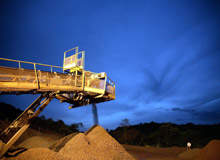
Located in the deep Northwest of Australia, Rio Tinto’s Pilbara mines are capable of producing up to 220 million tons of iron ore a year. An integral location for Rio Tinto, the site has taken on an acute technology focus that includes the development of a remote operations centre (ROC) in Perth that will eventually control trains, drills and tracks from as far as 1,300km away. External relations manager Gervase Greens gives Alex Hawkes a lowdown on the company’s path towards an automated mine of the future.
Alex Hawkes: Why in particular were the Pilbara mines in Australia selected for the implementation of such advanced technology?
Gervase Greens: While it is not the only site we have been bearing a technology focus on, it is a particular priority. This happened not necessarily by design but rather because the management there were forward minded and one innovation has lead to another.
We have 11 iron ore mines in the Pilbara mines but the West Angeles mine there has become a de-facto trial for innovation – whether its automated trucks, automated drills and blasts or automated logistics applications. There is obviously more opportunity to implement technologies in the new mines rather than the older ones as it is not a matter of adjusting existing methods and practices.
The same design plans for one mine can be applied to another compound and likewise a similar economy of scale and experience can be applied to new technologies. We have applied the same template to three of our newest mines which just happen to be in East Pilbara. However, we aim to bring the same template to West Pilbara and as we intend to open a minimum of one to two mines every year for the next few years, we will be applying the template then too.
AH: How important is the ROC in Perth to the entire operation?
GG: The ROC is currently being built near Perth’s domestic airport and is expected to be completed by 2009. It will house around 350 employees who will oversee, operate and optimise the use of key assets and processes, including all mines, processing plants, the rail network, ports and power plants. Operational planning and scheduling functions will also be based in the ROC, which features an operational control room, office block and supporting infrastructure.
Originally there was an East Pilbara block, which was in effect a trial version of the ROC that operated the West Angeles mine. The managers supervised the running of the mine remotely from the building to see if it was possible to do and it was. The mine was situated 10,000km away from the block and relied on long extension cords, similar to how the completed ROC will operate. We therefore used the building to train employees for the ROC.
The main benefit the ROC will have for Rio Tinto once it is completed is the centralisation it will offer.
It is difficult to achieve collation on an operation of our scale, but having maintenance, rail, HR and all other departments located together will certainly help. Furthermore there is a high attrition rate in the Pilbara mines. It is not an easy place to live, especially if you have family, and we have found that often staff leave as they want to be located closer to Perth. This is therefore as much about staff retention as anything else.
AH: Where did the concept of driverless trains come from and how will it enhance efficiency at the Pilbara mines?
GG: Automated trains have been around for some time in airports but they are not used on a heavy-oil long-haul railway network of this scale. We believe the network at the Pilbara mines to be one of the largest private railways in the world, so although the technology is not new, the scale is.
The railway stretches from our Pilbara ports to the mines, which covers roughly 330km. It’s a long stretch and train drivers can only physically drive so far before being replaced. We only have a single driver per train, with each train stretching over 2.5km-long usually consisting of 230 carriages. We cannot find enough train drivers to maintain our expansion forward and the ones we are hiring are getting older and harder to replace.
Every open-tech mining network manages to produce value by reducing incremental delays. Rail inevitably involves delays or bottlenecking. It is critical the loads reach the port in time as the ship departure times are dependent on tide, so a half-hour delay can be very costly. Autonomous train operations ensure predictability and constancy.
AH: What is unique about Rio Tinto’s recent partnership with the Japanese company Komatsu?
GG: We are currently trialling Komatsu trucks at the West Angeles mine. The first ones arrived only in the last two months so it is still early days. Komatsu Autonomous Haulage Systems have previously been operated in a copper mine in Chile, but it is certainly not heard of in Australian iron ore mining before.
The system relies heavily on the use of sensor technology which we believe to be a very promising technology. The automation brings with it greater safety to workers. Historically, mining has always been tough and dirty and even deadly, so Rio Tinto will do everything it can to avoid or litigate that.
AH: How pivotal is technology for the future of Rio Tinto?
GG: In recent years, it has become clear there is reward in investing in technology. We came to a fork in the road and embraced technology. Our strategy is to develop large assets with long life and low costs.
More than anything, technology makes economical sense for iron ore mining. Rio Tinto’s chief executive promised a mine of the future and that is exactly what we are always trying to achieve.



